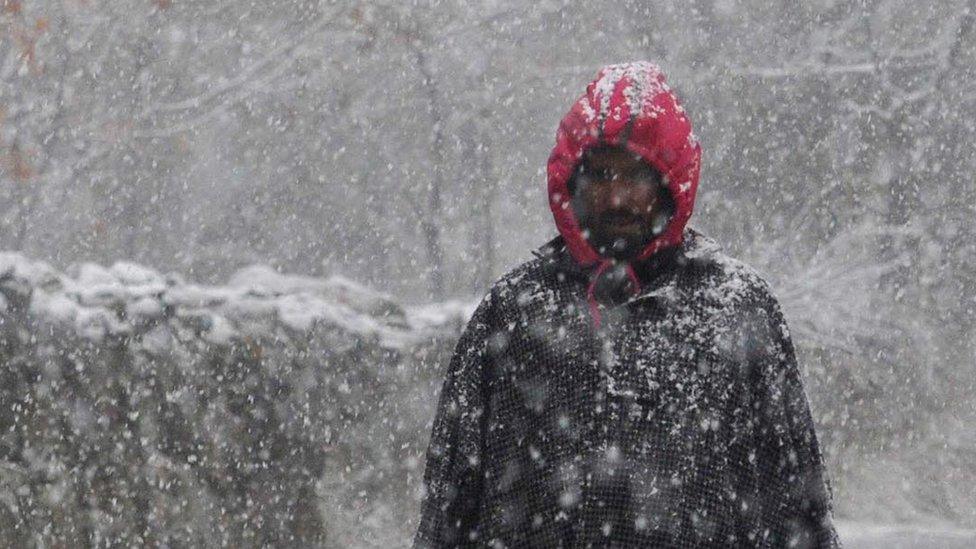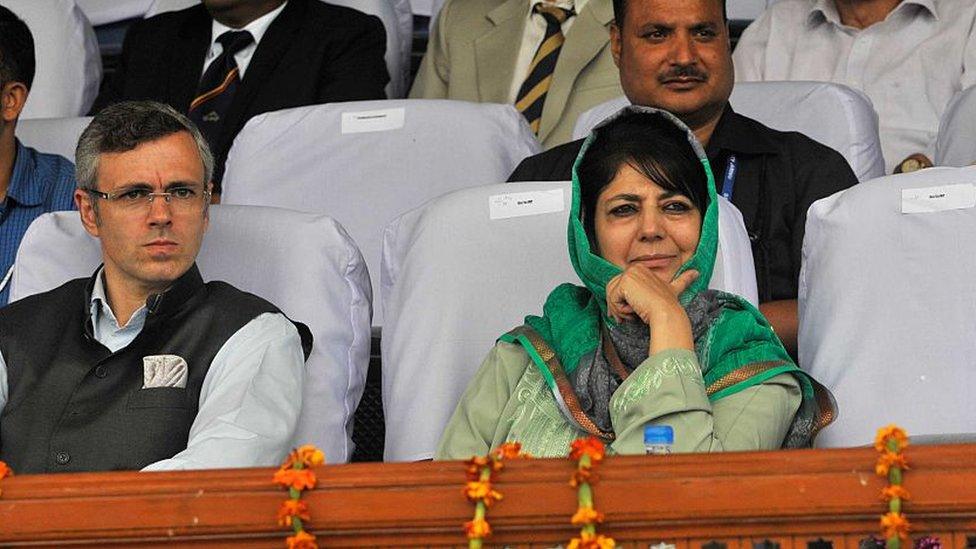Why are Kashmiris sharing photos of traditional dress?
- Published

A man wearing a traditional pheran walks through heavy snowfall in Srinagar
Officials in Indian-administered Kashmir have reversed an education department ban on employees wearing traditional dress to work, following an outcry on social media.
"All officials visiting the office are advised to visit in proper dress code during any official visit. It is recommended that no official will visit this office wearing pheran, traditional trousers and slipper/plastic shoes," an 11 December circular said.
In response, Kashmiri social media users protested by sharing images of themselves wearing the pheran - a traditional long coat or cloak worn by both men and women.
The ban was later scrapped, though a separate local government proscription on wearing the pheran remains in place in the Civil Secretariat in Srinagar city.
The outcry comes as Indian-administered Kashmir remains under direct rule from Delhi after the collapse of the coalition government led by former Chief Minister Mehbooba Mufti in June.
Many of those to post decried what they saw as an attack on their cultural heritage.
Omar Abdullah, a former chief minister of Jammu and Kashmir, described the ban as "regressive".
Allow X content?
This article contains content provided by X. We ask for your permission before anything is loaded, as they may be using cookies and other technologies. You may want to read X’s cookie policy, external and privacy policy, external before accepting. To view this content choose ‘accept and continue’.

Some of those sharing images told of the significance of the pheran to them.
Allow X content?
This article contains content provided by X. We ask for your permission before anything is loaded, as they may be using cookies and other technologies. You may want to read X’s cookie policy, external and privacy policy, external before accepting. To view this content choose ‘accept and continue’.

Others described the ban as a "cultural onslaught" and pointed to the practical benefits of the long cloak in cold weather.
Allow X content?
This article contains content provided by X. We ask for your permission before anything is loaded, as they may be using cookies and other technologies. You may want to read X’s cookie policy, external and privacy policy, external before accepting. To view this content choose ‘accept and continue’.

Allow X content?
This article contains content provided by X. We ask for your permission before anything is loaded, as they may be using cookies and other technologies. You may want to read X’s cookie policy, external and privacy policy, external before accepting. To view this content choose ‘accept and continue’.

Inevitably, at least one social media user looked to cats to make their point.
Allow X content?
This article contains content provided by X. We ask for your permission before anything is loaded, as they may be using cookies and other technologies. You may want to read X’s cookie policy, external and privacy policy, external before accepting. To view this content choose ‘accept and continue’.


You may also be interested in:

Abdul Rashid, the zonal education officer who ordered the ban, confirmed to the Indian Express, external it had been overturned.
"People used to walk into offices wearing pherans and... I had asked for that to be banned," he said.
"The chief education officer called me and asked me to revoke the order, so I have."
This is not the first time the pheran has been proscribed.
In 2014, the Indian army told journalists not to wear the pheran while visiting a corps headquarters in Srinagar.
Later, the army retracted the order, saying the guideline had been "inadvertent".
By BBC UGC and Social News and Pratik Jakhar, BBC Monitoring
- Published22 November 2018
